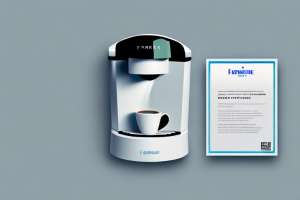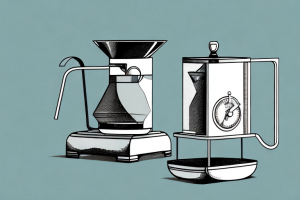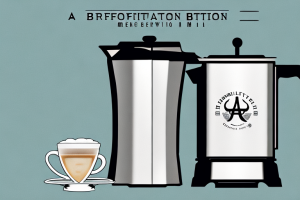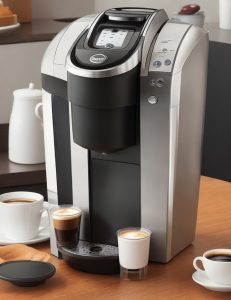12 Cup Coffee Maker How Much Coffee

A 12-cup coffee maker with a carafe full of coffee
If you are a coffee lover, then you know the importance of a good cup of coffee in the morning. One of the best ways to get your daily caffeine fix is by using a 12-cup coffee maker. However, getting the perfect brew can be a bit of a challenge. If you’re wondering “how much coffee to use in my 12-cup coffee maker?” then you’ve come to the right place. In this article, we’ll explore the ins-and-outs of brewing a delicious cup of coffee in your 12-cup coffee maker.
Understanding the Basics of Coffee-to-Water Ratio
The first step to brewing a delicious cup of coffee is understanding the coffee-to-water ratio. This is the proportion of coffee that should be used in relation to the water. For a 12-cup coffee maker, it is recommended that you use around 68-72 grams of coffee for 12 cups of water. However, this can vary depending on your taste preferences.
It is important to note that the type of coffee beans you use can also affect the coffee-to-water ratio. Darker roasts tend to have a stronger flavor, so you may need to use less coffee to achieve the desired taste. On the other hand, lighter roasts may require more coffee to get the same level of flavor.
Another factor to consider is the grind size of the coffee. A finer grind will require less coffee, while a coarser grind will need more. It’s important to experiment with different ratios and grind sizes to find the perfect balance for your taste buds.
How to Measure Coffee Accurately for Your 12-Cup Maker
Measuring your coffee correctly is crucial to achieving a perfect cup every time. The best method for measuring coffee is by weight, using a kitchen scale. But, if you don’t have a scale, then using measuring spoons is also a viable option. One tablespoon of coffee typically weighs around 7 grams, so you can use this as a guide when measuring out your coffee.
Another important factor to consider when measuring coffee is the roast level. Lighter roasts are denser and require more coffee per cup, while darker roasts are less dense and require less coffee per cup. It’s important to adjust your measurements accordingly based on the roast level of your coffee.
Additionally, the type of coffee maker you are using can also affect the measurement of coffee needed. For example, a French press requires a coarser grind and more coffee per cup, while a drip coffee maker requires a finer grind and less coffee per cup. Be sure to read the instructions for your specific coffee maker and adjust your measurements accordingly.
The Importance of Using Fresh and Quality Coffee Beans
The quality of your coffee beans plays a significant role in the final taste of your brew. It is best to use fresh and quality coffee beans, which have been roasted recently. If you can, try to grind your coffee beans just before brewing. This way, you’ll enjoy the full pot of flavors and aroma of your coffee.
Additionally, using fresh and quality coffee beans can also have health benefits. Coffee beans contain antioxidants, which can help protect your cells from damage caused by free radicals. They also contain caffeine, which can improve mental alertness and reduce the risk of certain diseases, such as Parkinson’s and Alzheimer’s. So, not only will you enjoy a better tasting cup of coffee, but you’ll also be doing your body a favor by using fresh and quality coffee beans.
Different Types of Coffee Beans and Their Flavors
Did you know that there are different types of coffee beans, with distinct flavors? The two most common types of coffee beans are Arabica and Robusta. Arabica beans have a sweeter, more complex flavor with a lower acidity, while Robusta beans have a stronger, bitter taste and higher caffeine content.
Aside from Arabica and Robusta, there are other types of coffee beans that are worth exploring. For instance, Liberica beans have a unique smoky and woody flavor, while Excelsa beans have a tart and fruity taste. Additionally, there are specialty coffee beans such as Geisha and Blue Mountain, which are known for their exceptional quality and distinct flavor profiles. Exploring different types of coffee beans can be a fun and exciting way to discover new flavors and expand your coffee palate.
Decoding the Water Temperature for Optimal Brewing
The temperature of the water used in brewing coffee is also essential. For the perfect brew, the water should be between 195-205°F (90-96°C). Boiling water should be avoided, as it can result in a burnt taste to your coffee.
However, the water temperature can also vary depending on the type of coffee you are brewing. For example, if you are brewing a light roast coffee, a lower water temperature of around 185-195°F (85-90°C) is recommended. This is because a lower temperature allows for the delicate flavors of the light roast to shine through.
On the other hand, if you are brewing a dark roast coffee, a higher water temperature of around 205-212°F (96-100°C) is recommended. This is because the higher temperature helps to extract the bold flavors and oils from the dark roast beans.
Exploring the Various Grind Sizes for Different Brewing Methods
The grind size of coffee beans affects the flavor of the coffee, as different methods of brewing require different grinds. For a 12-cup coffee maker, a medium-coarse grind is recommended. This allows for optimal extraction of flavor and aroma.
For a French press, a coarse grind is recommended. This is because the coffee is steeped in water for a longer period of time, and a coarse grind allows for a slower extraction process. A fine grind, on the other hand, is recommended for espresso machines. This is because the water is forced through the coffee grounds quickly, and a fine grind allows for a faster extraction process.
It is important to note that the type of coffee beans also plays a role in determining the appropriate grind size. For example, darker roasts may require a coarser grind to prevent over-extraction and bitterness, while lighter roasts may require a finer grind to extract more flavor and aroma.
How to Adjust the Strength of Your Brew with Quantity and Grind Size
The strength of your coffee can be adjusted by varying the quantity of coffee used per cup, or by changing the grind size. If you feel that your coffee needs to be stronger, try increasing the amount of coffee used slightly. Alternatively, if your coffee is too strong, reduce the coffee quantity or grind it slightly coarser.
It’s important to note that the type of coffee beans you use can also affect the strength of your brew. Darker roasts tend to have a stronger flavor, while lighter roasts are milder. Experiment with different types of beans to find the perfect strength for your taste buds.
Tips for Maintaining Your 12-Cup Coffee Maker for Optimal Performance
Regular cleaning and maintenance of your 12-cup coffee maker is crucial to ensure optimal performance and longevity. Always refer to the manufacturer’s guidelines for cleaning instructions. Using filtered water can also help in reducing the mineral buildup in your coffee maker.
In addition to regular cleaning and using filtered water, it is important to descale your coffee maker every few months. Descaling removes mineral buildup that can affect the taste of your coffee and the performance of your machine. You can use a descaling solution or a mixture of vinegar and water to descale your coffee maker. Follow the manufacturer’s instructions for descaling and always rinse thoroughly afterwards.
Understanding the Role of Filters in Brewing Quality Coffee
Filters play a significant role in brewing quality coffee. Always use fresh filters for each brewing session, as dirty or clogged filters can negatively impact the final taste of your coffee. If you prefer, you can also explore the use of reusable filters.
There are different types of filters available in the market, such as paper, metal, and cloth filters. Each type of filter has its own advantages and disadvantages. Paper filters are the most commonly used filters as they are affordable and easy to use. Metal filters, on the other hand, are reusable and can be washed and reused multiple times. Cloth filters are also reusable and are known for producing a rich and full-bodied coffee.
It is important to choose the right filter based on your personal preference and the type of coffee you are brewing. For example, if you are brewing a light roast coffee, a paper filter may be the best option as it will produce a clean and bright cup. However, if you are brewing a dark roast coffee, a metal or cloth filter may be a better choice as it will allow more oils and flavors to pass through, resulting in a richer and more complex cup of coffee.
The Pros and Cons of Single-Serve vs 12-Cup Coffee Makers
Single-serve coffee makers are gaining popularity due to their convenience and flexibility. However, a 12-cup coffee maker still has its place for those who want to brew a pot of coffee for multiple people. It is best to weigh the pros and cons of each type of coffee maker, and choose the one that best suits your needs.
One of the main advantages of single-serve coffee makers is that they allow you to brew a fresh cup of coffee every time, without wasting any coffee. This is especially useful for those who only drink one or two cups of coffee a day. On the other hand, 12-cup coffee makers are more cost-effective for those who drink multiple cups of coffee a day, as they can brew a larger quantity of coffee at once.
Common Mistakes to Avoid When Brewing with a 12-Cup Coffee Maker
Some common mistakes that people make when brewing with a 12-cup coffee maker involve not using the correct coffee-to-water ratio or temperature, not cleaning the machine regularly, and using old or stale coffee beans. To avoid making these mistakes, refer to the tips mentioned earlier in this article.
Another common mistake to avoid when brewing with a 12-cup coffee maker is not using the correct grind size for your coffee beans. Using the wrong grind size can result in over-extraction or under-extraction, leading to a bitter or weak cup of coffee. It’s important to match the grind size to the brewing method and the type of coffee maker you’re using. For a 12-cup coffee maker, a medium grind size is usually recommended.
Experimenting with Add-Ins like Milk, Cream, and Flavorings
Once you have mastered the art of brewing coffee in your 12-cup coffee maker, you can start experimenting with various add-ins like milk, cream, and flavored syrups. These can help personalize your cup of coffee to your tastes.
How to Store Your Coffee Beans for Maximum Freshness
The best way to store coffee beans is by keeping them in an airtight container, away from moisture, heat, and light. It is also advisable to buy coffee beans in small quantities and use them up within a week or two for maximum freshness.
Enjoying Your Perfectly Brewed Cup of Joe from a 12-Cup Maker
After all is said and done, the most crucial step in brewing a great cup of coffee is to enjoy it. Savor the flavors and the aroma of your perfectly brewed coffee and start your day off on the right foot.
In conclusion, brewing coffee in your 12-cup coffee maker can be simple, provided you follow some essential steps. Get the coffee-to-water ratio right, use fresh and quality coffee beans, brew at the right temperature, and clean your coffee maker regularly. With these tips and tricks under your belt, you’ll be able to brew a perfect cup of coffee every time.



